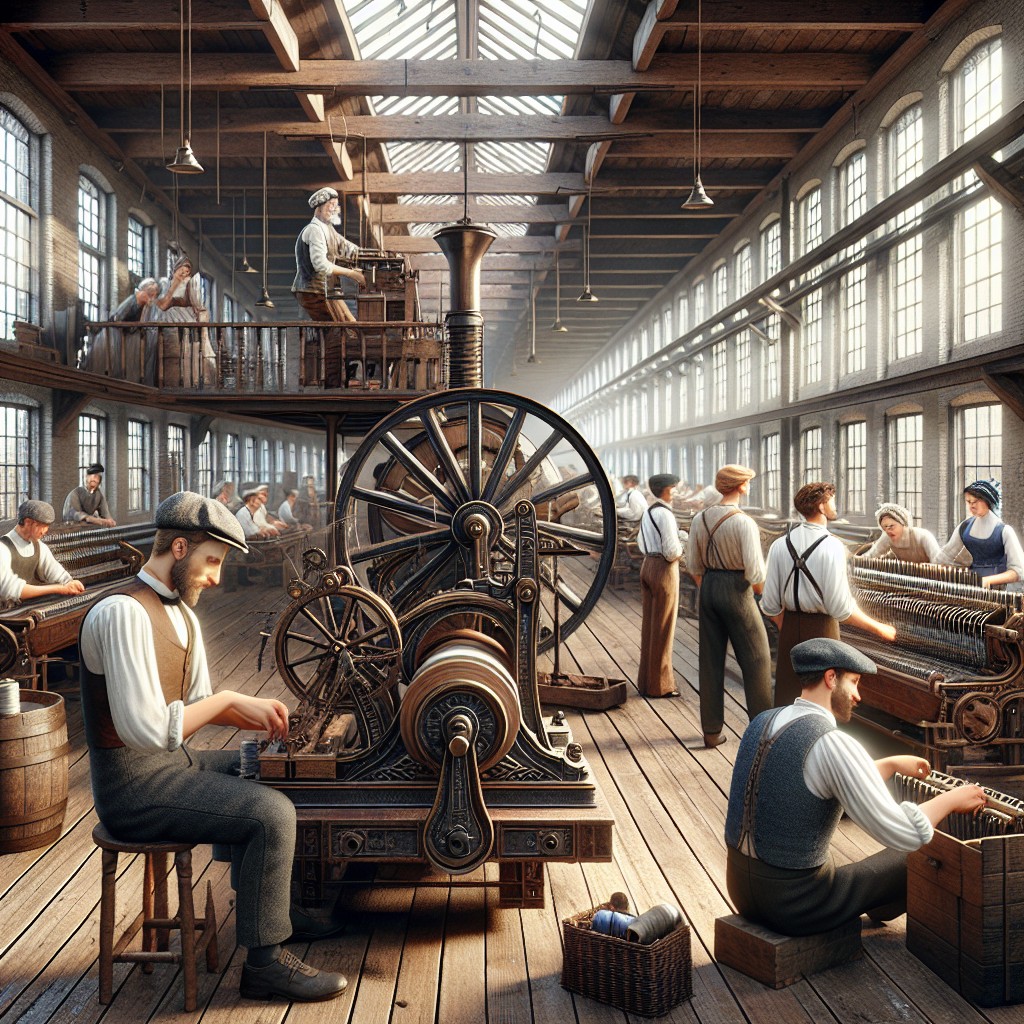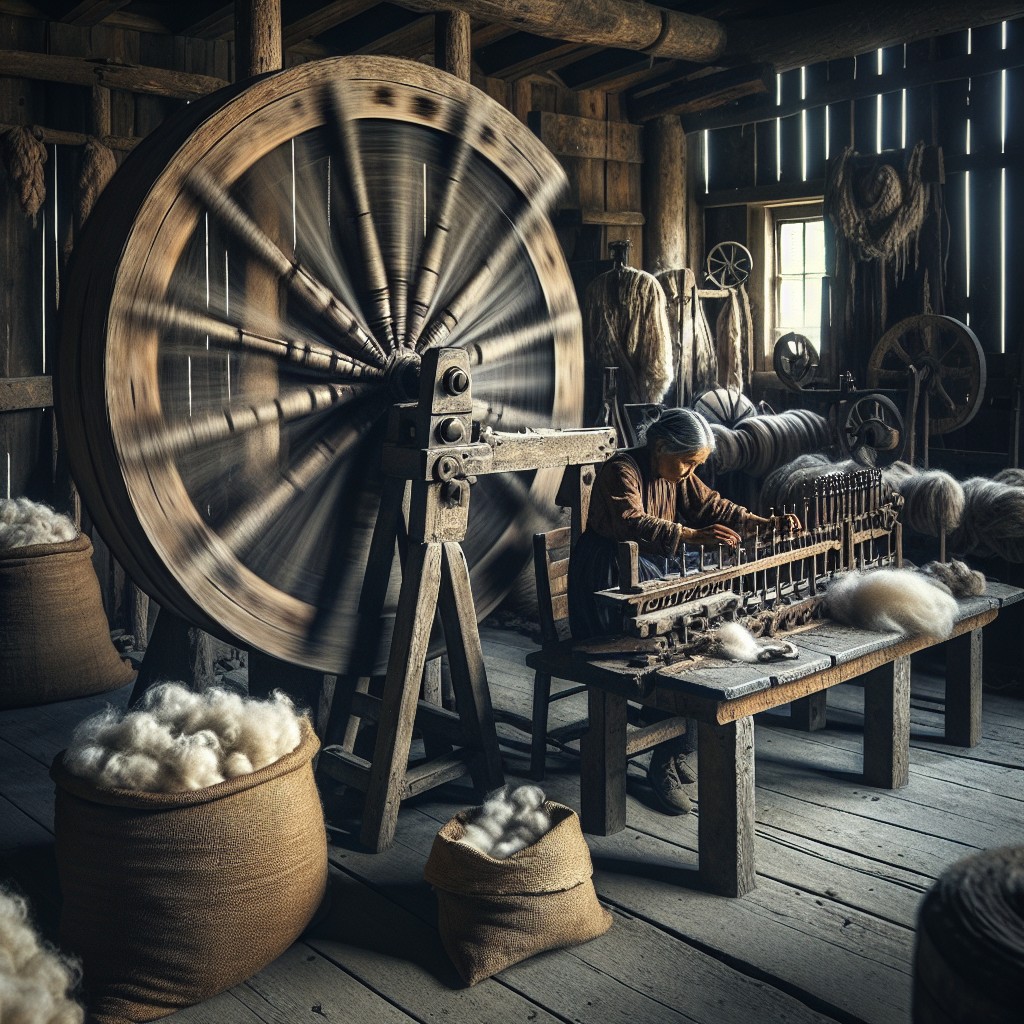Explore the fascinating world of the Canadian Production Wheel because understanding its history, maintenance, and usage could elevate your knitting and crocheting craftsmanship to new heights.
Key takeaways:
- CPWs were developed in 19th century Quebec for efficient wool spinning.
- Longer staple length wools like Coopworth and Romney are ideal for CPWs.
- CPWs have large drive wheels for rapid spinning and intricate designs.
- Maker’s stamps on CPWs indicate origin and can guide repairs.
- Regular oiling and maintenance ensure smooth operation of CPWs.
History of the Canadian Production Wheel

The Canadian Production Wheel (CPW) has its origins in the 19th century, developed during a time when home spinning was a common task. Crafted mainly in Quebec, these wheels were integral to the cottage industry of textiles, providing efficiency and speed for production. The large drive wheel, often exceeding 30 inches in diameter, is a defining feature and contributed to their reputation for fast wool spinning, thus garnering the name “production” wheel.
Designed to meet the demand for wool yarn, the CPW could be produced quickly and sold at an accessible price, making it a mainstay in Canadian households. Its prevalence grew alongside the wool industry, symbolizing both utility and the era’s craftsmanship. The wheels were often adorned with unique Quebecois folk art and the craftsmanship can vary based on the artisan who created it, making each CPW a functional piece of art.
As factory production increased in the late 19th and early 20th centuries, the use of CPWs waned. However, modern spinners deeply appreciate these historic wheels for their utility and aesthetic. Renowned for their fast spinning capabilities and durability, CPWs have become sought after by those looking to connect with traditional spinning practices.
The Fiber for This Project

When considering the type of fiber for use with a Canadian Production Wheel (CPW), selecting a longer staple length wool is ideal. This staple length eases the process of long draw spinning, which the CPW is known for. Typical fibers might include:
- Coopworth or Romney: These wools have a longer staple length, which makes them well-suited to the CPW. The consistency and strength of the fibers are conducive to the wheel’s mechanics, allowing for smooth spinning.
- Mohair: With its long fibers and lustrous finish, mohair can be a good choice for those looking to produce a yarn with a sheen and excellent drape.
- Lincoln or Border Leicester: The lengthy and robust fibers of these breeds handle the tension and pace of the CPW efficiently, producing a strong yarn suitable for durable projects.
It’s important to select a fiber that won’t easily break under the tension of the wheel, allowing you to take advantage of the CPW’s rapid spinning capabilities without frequent interruptions. Preparing your fiber adequately, through carding or combing, will also enhance your spinning experience, ensuring the fibers are properly aligned and free from tangles.
CPW Drive Wheel Characteristics

A distinguishing feature of the Canadian Production Wheel (CPW) is its large drive wheel, often measuring 30 inches or more in diameter. This wheel size allows for increased speed and momentum, making the CPW ideal for rapid and efficient spinning.
The drive wheel’s vast circumference translates into fewer treadles per length of yarn, enabling spinners to produce yarn more quickly compared to smaller wheels. Additionally, the high ratio of the drive wheel to the flyer means that each treadle imparts more twist into the fiber, a feature particularly well-suited to spinning finer threads.
Crafted primarily from wood, the drive wheel’s construction was designed not only for function but also for aesthetic appeal, often featuring intricate turnings and a balanced, symmetrical form. The balanced construction ensures smooth operation and minimizes wobble, enhancing the spinner’s rhythm and reducing fatigue.
In essence, the CPW’s drive wheel is a pivotal component that contributes to both its visual elegance and its reputation as a workhorse among spinning wheels.
CPW Maker’s Stamp

Identifying the maker’s stamp on a Canadian Production Wheel (CPW) can provide valuable information about its origin and age. Often found on the wheel table or the underside of the bench, these marks indicate the craftsman or manufacturing company responsible for the creation of the wheel.
The maker’s stamp is typically a burn or ink stamp, and less commonly, a paper label.
Certain stamps can indicate a higher value, especially those from renowned makers like David Paradis or the Merrill and Wilder company.
Knowledge of specific stamps may inform repairs and restorations, as knowing the manufacturer can guide the materials and techniques used.
Collectors and enthusiasts often use these stamps to trace the history of their wheels, contributing to the larger history of textile crafts in Canada.
Cross-referencing the stamp with databases or resources on CPWs can reveal the time period during which the wheel was made.
The CPW Drive Wheel Hub
The hub is central to the operation of any spinning wheel, acting as the pivotal point around which the wheel rotates. On the Canadian Production Wheel (CPW), the hub is designed for durability and smooth rotation, with many featuring built-in bearings to reduce friction. Large in diameter, the hub helps to maintain a steady momentum once the wheel is in motion, enabling longer, more efficient spinning sessions.
The design of the hub is crucial for the CPW’s high-speed capabilities. It typically supports the wheel’s double drive system, where the drive band loops around both the flyer and the bobbin, requiring a hub that can withstand the additional tension without warping.
When caring for the CPW, pay special attention to the hub. Regular cleaning to remove any lint or yarn fibers ensures unimpeded motion. Additionally, applying a few drops of appropriate oil to the hub bearings, if accessible, facilitates effortless wheel movement which contributes to the spinner’s control and yarn consistency.
Oiling Your CPW
Regular oiling is a crucial step in keeping your Canadian Production Wheel (CPW) running smoothly. A well-lubricated wheel enhances the spinning experience and prolongs the life of the wheel.
Here are some key points to consider when oiling your CPW:
- Use the right oil: A light, clear oil, such as spinning wheel oil or even clock oil, is best. Avoid heavy oils that can attract dust and grime.
- Focus on moving parts: Apply oil to any part of the wheel that moves against another part. This includes the axle ends, treadle joints, and flyer assembly.
- Be moderate: A few drops of oil are sufficient. Over-oiling can collect dirt and cause the wood to swell, leading to further friction.
- Regularity is key: Oil your CPW before each spinning session for optimal performance. If you spin frequently, a weekly check may be necessary.
- Listen to your wheel: Squeaks or stiff movement are indicators that the wheel needs attention. Oiling can often quickly resolve these issues.
Remember, a little preventive maintenance can keep your CPW spinning effortlessly for years to come.
Understanding the Double Drive System
The double drive system is a distinctive feature of the Canadian Production Wheel (CPW) that simultaneously powers both the flyer and the bobbin, allowing for a smooth and swift spinning process. This system uses a single, long drive band looped twice around the wheel; it goes over the flyer whorl once and the bobbin whorl once.
Here’s what you need to know about how it works:
- Tension and Take-Up: The double drive provides an even tension and consistent take-up, which is essential for uniform yarn production. The tension is adjusted by increasing or decreasing the distance between the mother-of-all and the drive wheel.
- Speed Regulation: The relative speeds of the flyer and bobbin can be regulated by changing the size of the whorls. This helps in managing the twist and uptake of the yarn, suitable for various spinning techniques.
- Smooth Operation: With this system, the drive band has less tendency to slip or cause the bobbin and flyer to stop, promoting uninterrupted spinning.
- Compatibility with Various Fibers: Whether working with delicate fibers like angora or robust ones like wool, the double drive system can accommodate a range of materials effectively.
Remember to monitor the tension of the drive band; it should be firm but not overly tight, to prevent unnecessary wear on the wheel components and ensure optimal performance.
Maintenance of Leather Bearings
Proper maintenance of leather bearings on your Canadian Production Wheel (CPW) is paramount to ensuring smooth operation and longevity of the wheel. The leather bearings support the axle, allowing the wheel to spin with minimal friction.
Regular Inspection: Before each spinning session, inspect the leather bearings for signs of wear or dryness. If the leather appears dry, it may cause unnecessary friction and noise.
Lubrication: Use a small amount of leather conditioner or neat’s-foot oil to keep the bearings supple. Apply the oil sparingly to a cloth and rub gently onto the leather, making sure not to over-saturate, as this can attract dust and lint.
Avoid Over-Oiling: Excess oil can cause the leather to become too soft, which may result in the bearings not supporting the axle effectively. It can also lead to the accumulation of grime, which could impair the movement of the wheel.
Replacement: When you notice significant wear or if the leather no longer holds its shape, it’s time to replace the bearings. Select the appropriate size and thickness of leather to match the existing bearings.
Climate Considerations: Be aware that extreme temperatures and humidity levels can affect the condition of the leather. In very dry environments, more frequent conditioning may be necessary.
By following these simple maintenance steps, you can help ensure that your CPW operates at its best and your spinning sessions remain a joy.
Executing Long Draw Spinning On the CPW
With its rapid treadling and large drive wheel, the Canadian Production Wheel (CPW) is especially suitable for the long draw spinning technique, which is ideal for creating woolen yarns with a soft, lofty character.
To harness this technique effectively:
- Start with Proper Preparation: Before beginning, ensure your fiber is well-carded and presented in a rolag or light airy batt; this preparation is crucial for a successful long draw.
- Maintain Consistent Tension: Set your wheel’s tension to have a steady take-up without overly strong pull. The CPW’s large wheel allows for a broad range of tension adjustments to find the sweet spot for your spinning style.
- Use a Light Touch: The long draw requires a delicate hand. Pinch the fiber supply just lightly enough to control twist entry, and allow the twist to travel back into the drafting zone for a smooth draft.
- Establish Rhythm: The CPW’s wheel encourages a steady pace. Match your treadling speed with your drafting to achieve a rhythmic flow, which is essential for even yarn creation.
- Practice Consistency: Aim for consistency in your draw length and release. This regularity ensures each section of yarn has a uniform thickness and twist for a professional finish.
By focusing on these points, you can make the most of the CPW’s design, enjoying the satisfying experience of creating woolen-spun yarn with the long draw spinning technique.
Further Reading On Canadian Production Wheels
For enthusiasts seeking to deepen their understanding of Canadian Production Wheels, a variety of resources are available. Books such as “Spinning Wheels, Spinners & Spinning” by Patricia Baines provide historical context and technical details on spinning wheels, including CPWs.
Online forums like Ravelry have dedicated groups where collectors and spinners share information, restoration tips, and troubleshooting advice.
The Canadian Museum of History offers insights into the cultural heritage of spinning in Canada, which may include information on production wheels.
Blogs by antique wheel enthusiasts often include detailed posts about individual wheel restorations, including CPWs.
YouTube channels hosted by spinners can also be a visual guide for those who prefer a step-by-step tutorial on working with these wheels.
FAQ
What is a Canadian production wheel?
A Canadian production wheel is a double drive spinning wheel with cast iron parts and a tilt tension system, specifically produced in Quebec between 1875 and 1935.
What does the spinning wheel symbolize?
The spinning wheel symbolizes unity, political power, and economic activity, particularly in South Asia, as well as a recurring theme in various art and literature forms.
Where are lendrum spinning wheels made?
Lendrum spinning wheels are manufactured in the small town of Odessa, Ontario, Canada.
How does a flax wheel differ from a Canadian production wheel in functionality?
A flax wheel is designed specifically for spinning flax fibers into linen, featuring a distaff to hold the unspun fibers, while a Canadian production wheel, built for high-volume yarn production, lacks a distaff and typically has larger wheel diameter for increased speed and efficiency.
What are the key features to look for when purchasing a used Canadian production wheel?
When purchasing a used Canadian production wheel, key features to look for include a sturdy construction, smooth operation, intact and functional flyer and bobbin system, along with a wheel that rotates freely and is consistent in size and shape.
How has the design of the Canadian production wheel evolved over time?
The design of the Canadian production wheel evolved over time by incorporating larger wheels for speed, slim profiles to save space, and intricate features to improve yarn quality and consistency.





